U
IMS = R
RAS.MAH / I
N. In our example, U IMS = 20 W / 3 A = 6.6 V, thus the maximum voltage rectifier must be U = U new IP + U IMS = 12V + 6.6 V = 18.6 B. The number of turns of the transformer secondary windings will diminish. Resistance ballast resistor R1 in the pattern shown in Fig.7, you can count on the formula:
R1 = (U IP - U CT) / I ST, where U ST and ST I - respectively voltage and current stabilization stabilitrona. The limits of the current stabilization can be found in the handbook, in practice for low stabilitronov his choosing within 7 ... 15 mA (typically 10 mA). If the current in the above formula to express in milliampere, the amount of resistance to get in kiloomah.
A simple laboratory power supply.
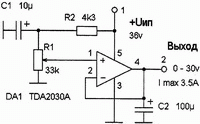
By varying the voltage at the entrance of IMS using potentiometer R1, produced a smooth adjustable output voltage. The maximum current, given a chip, depending on the output voltage and restricted the same maximum dissipated power at IMS. Calculate it could be the formula:
I MAX = R RAS.MAH / U IMS
For example, if the output voltage U billed VYH = 6, the chip is happening voltage drop U IMS IP = U - U VYH = 36 - 6 = 30, therefore, the maximum current is I MAX = 20 W / 30 = 0.66 A. When U VYH = 30 V maximum current can reach a maximum of 3.5 A, as well as a drop in the IMS slightly (6).
Stabilized laboratory power supply.
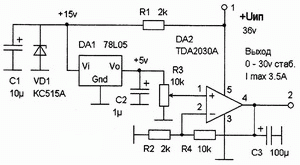
Source stabilized reference voltage - chip DA1 - powered by Parametric stabilizer at 15, collected at stabilitrone VD1 and resistor R1. Should IMS nurture DA1 directly from the source +36 V, it can be easily damaged (the maximum input voltage for IMS 7805 is 35 V). IMS DA2 included on the scheme neinvertiruyuschego amplifier gain which is defined as 1 + R4/R2 and is 6. Consequently, the output voltage adjustment potentiometer R3 can take the value from nearly zero to 5 * 6 = 30 V. With regard to the maximum output current, for this scheme true all this for a simple laboratory power supply (Fig.9). If it is less regulated output voltage (for example, from 0 to 20 in the U IP = 24), elements VD1, S1 can be excluded from the scheme, but instead R1 set the jumper. If necessary, the maximum output voltage can change the selection of resistance resistor R2 and R4.
An adjustable current source.
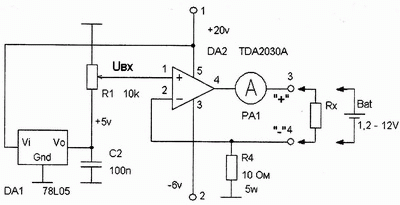
At the entrance inverting IMS DA2 (concludes 2), thanks to the OOS through resistance load, supported by tension U BX. As can be seen from the formula, load current does not depend on the resistance loads (of course, up to certain limits, due to end-voltage IMS). Therefore, changing the U BX from zero to 5 V using potentiometer R1, with the fixed value of resistance R4 = 10 ohms, can be controlled through the current strain of 0 ... 0.5 A. The device can be used for charging batteries and electroplating elements. Charging current stable throughout the cycle of charging and does not depend on the amount of discharge of the battery or the instability of the supply network. The maximum charging current, displayed using potentiometer R1, you can change, increasing or decreasing resistance resistor R4. For example, when R4 = 20 ohms, it has a value of 250 mA, and with R4 = 2 ohms reaches 2.5 A (see formula above). For the scheme are fair restrictions on the maximum output current, both for stabilizing voltage circuits. Another application of a powerful inhibitor of current - measuring small resistance through voltmetra on a linear scale. Indeed, if the value of a current exhibit, for example, 1 A, is connected to the scheme resistor 3 ohms resistance, Ohms law to get the voltage drop its U = l * R = l A * 3 ohms = 3 V, and connecting, say, resistor resistance 7.5 ohms, we get a drop 7.5 V. Of course, this current can be measured only powerful Low resistors (3 V at 1 A - is 3 W, 7.5 V * 1 A = 7.5 W) But you can reduce the measured current and use the voltmeter to the lower limit of measurement.
A powerful generator of rectangular pulses.


Plans powerful generator of rectangular pulses are shown in Fig.12 (with bipolar diet) and Fig.13 (with unipolar meals). Plans can be used, for example, the device alarm. This chip includes a Schmitt trigger, and the whole scheme is a classic relaxation RC-oscillator. Consider the job figures. 12. Lets assume that at the time of the power output of IMS is moving towards a positive level of saturation (U VYH = + U IP). Capacitor C1 begins to be charged through resistor R3 with a constant time-Cl R3. When the voltage on C1 will reach half a positive voltage power source (+ U IP / 2), IMS DA1 switch to a negative saturation (U VYH =-U IP). Capacitor C1 will discharged through resistor R3 at the same time Cl R3 to the voltage (-U IP / 2) when the IMS again switches into a positive state of saturation. The cycle will be repeated with a 2,2 C1R3, regardless of the power supply voltages. Frequency pulses can count on the formula:
f = l / 2,2 * R3Cl. If the resistance to express kiloomah and capacity in mikrofaradah, the frequency will get in kilohertz.
A powerful low-frequency generator harmonic oscillations.
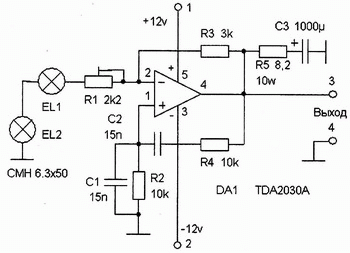
An electric circuit powerful low-frequency generator harmonic oscillations is shown in Fig.14. The generator gathered on a bridge Wines, formed by elements of DA1 and S1, R2, C2, R4, providing the necessary phase shift in the chain of PIC. Gain voltage IMS, with the same values of Cl, C2 and R2, R4 should be exactly equal to 3. With less importance Ku fluctuations fade, and an increased - dramatically increasing distortion of the output signal. Gain voltage determined resistance filament bulbs ELI, EL2 and resistors Rl, R3 and is Ky = R3 / Rl + R EL1, 2. Lamps ELI, EL2 serve as elements with variable resistance in the chain of OOS. When increasing the output voltage resistance of the filament lamp by heating increases, causing a decrease gain DA1. Thus, stabilizing the amplitude of the output signal generator, and minimize distortions of form sinusoidalnogo signal. Minimum distortion at the maximum possible output amplitude sought through podstroechnogo resistor R1. To exclude the impact of stress on the frequency and amplitude of the output signal at the output of the generator includes a chain R5C3, frequency oscillations generated can be determined by the formula:
f = 1/2piRC. Generator can be used, for example, in the repair and inspection heads speaker or speakers.
In conclusion, the chips must be installed on the radiator with ohlazhdaemoy surface area of not less than 200 cm 2. When razvodke agents of the printed circuit board for the amplifier must be Bass track to "earth" tires for input, as well as the power source and output summed with the different parties (conductors to these terminals should not be a continuation of one another, and assembled together to form stars "). This is necessary to minimize the background of the AC and eliminate possible self-amplifier with output power close to the maximum.

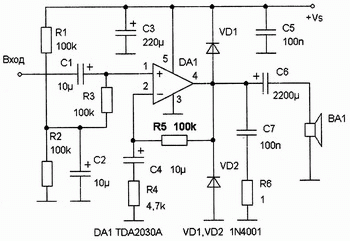
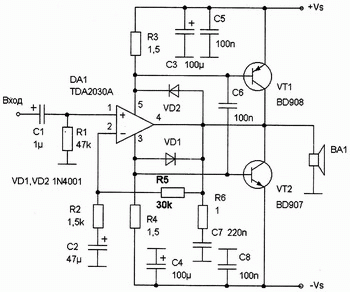











No comments:
Post a Comment